

The Open Source Hardware Bank. Plateforme de financement P2P - Prêt entre particuliers.
People to know-india. Microfinance in India. Loan a Little Change a Lot. Get Involved. Www.placement.coop. Theworkingworld.org. The Working World in New York The Working World is a non-profit organization re-imagining micro finance through innovative social investment techniques that equip people with the tools to build sustainable businesses in low-income communities.

Our mission is to support quality job growth and sustainable wealth creation in communities of need across the New York metropolitan area. Specifically, we create and support cooperative enterprises - businesses owned and run jointly by each person working there - through a combination of carefully tailored planning services and incisive, impact investments. In our sister funds in Argentina and Nicaragua, our results over the last six years have been amazing.
Operating with a small fund on a shoestring budget, in 2010 we completed more than two hundred productive investments together with cooperative enterprises, giving thousands of impoverished women and men the chance to take charge of their own working lives. Raiffeisen. Un article de Wikipédia, l'encyclopédie libre.
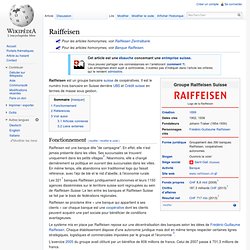
Groupe Raiffeisen Suisse Logo de la Raiffeisen Raiffeisen est un groupe bancaire suisse de coopératives. Il est le numéro trois bancaire en Suisse derrière UBS et Crédit suisse en termes de masse sous gestion. Fonctionnement[modifier | modifier le code] Raiffeisen est une banque dite "de campagne". Les 321[1] banques Raiffeisen juridiquement autonomes et leurs 1150 agences disséminées sur le territoire suisse sont regroupées au sein de Raiffeisen Suisse.
Raiffeisen se proclame être « une banque qui appartient à ses clients » car chaque banque est une coopérative dont les clients peuvent acquérir une part sociale pour bénéficier de conditions avantageuses. Le système mis en place par Raiffeisen repose sur une décentralisation des banques selon les idées de Frédéric-Guillaume Raiffeisen. L'exercice 2005 du groupe avait clôturé par un bénéfice de 608 millions de francs. Category:Peer-to-peer lending companies. Lending Club. History[edit] Early history[edit] Lending Club was initially launched on Facebook as one of Facebook's first applications.[2][9] After receiving $10.26 million in a Series A funding round in August 2007, from venture capital investors Norwest Venture Partners and Canaan Partners, Lending Club was developed into a full-scale peer-to-peer lending company.[2][10] On April 8, 2008, Lending Club temporarily suspended new lender registration, canceled its affiliate program and entered a "quiet period" while it awaited approval to issue promissory notes to lenders.[11] On June 20, 2008, Lending Club filed an S-1 statement[12] with the U.S.
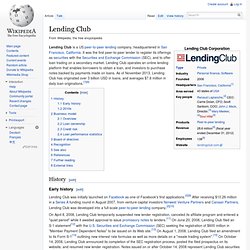
Kiva (organization) Since 2005, Kiva has crowd-funded more than 1 million loans, totaling more than a half a billion dollars, at a repayment rate of 99 percent.[4] As of Nov. 2013, Kiva was raising about $1 million every three days.[3] The Kiva platform has attracted a community of more than 1 million lenders from around the world.[5] Kiva operates two models—Kiva.org and KivaZip.org.
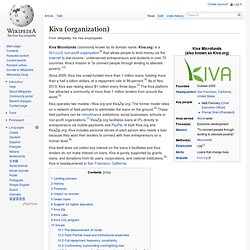
The former model relies on a network of field partners to administer the loans on the ground.[6] These field partners can be microfinance institutions, social businesses, schools or non-profit organizations.[7] KivaZip.org facilitates loans at 0% directly to entrepreneurs via mobile payments and PayPal. In both Kiva.org and KivaZip.org, Kiva includes personal stories of each person who needs a loan because they want their lenders to connect with their entrepreneurs on a human level.[8] Kiva itself does not collect any interest on the loans it facilitates and Kiva lenders do not make interest on loans.
Energy in Common. Energy in Common (EIC) is a not-for-profit organization, which is the first to enable microloans specifically and only for renewable energy technologies.
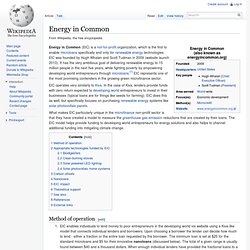
EIC was founded by Hugh Whalan and Scott Tudman in 2009 (website launch 2010). It has the very ambitious goal of delivering renewable energy to 15 million people in the next five years, while fighting poverty by empowering developing world entrepreneurs through microloans.[1] EIC represents one of the most promising contenders in the growing green microfinance sector. What makes EIC particularly unique in the microfinance non-profit sector is that they have created a model to measure the greenhouse gas emission reductions that are created by their loans. The EIC model helps provide funding to developing world entrepreneurs for energy solutions and also helps to channel additional funding into mitigating climate change.
Zidisha. The Zidisha website facilitates microlending transactions between individual web users worldwide and computer-literate, low-income entrepreneurs in developing countries.
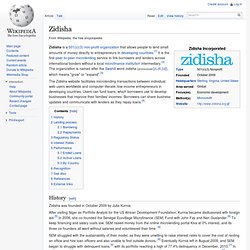
Users can fund loans, which borrowers use to develop businesses that improve their families' incomes. Borrowers can share business updates and communicate with lenders as they repay loans.[4] History[edit] Zidisha was founded in October 2009 by Julia Kurnia. After visiting Niger as Portfolio Analyst for the US African Development Foundation, Kurnia became disillusioned with foreign aid.[5] In 2006, she co-founded the Senegal Ecovillage Microfinance (SEM) Fund with John Fay and Nan Guslander.[6] To keep financing and salary costs low, SEM raised money from the online microlending portal Kiva at 0% interest, and its three co-founders all went without salaries and volunteered their time. [6] Kurnia's experience at SEM gave her visibility into the high operational costs of traditional microlenders.
Lending process[edit] 1. 2.